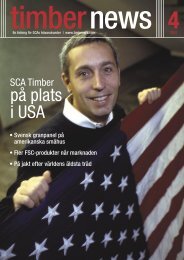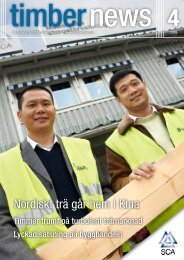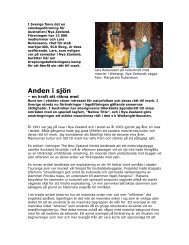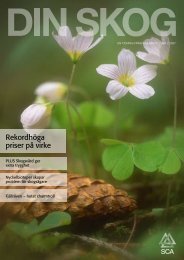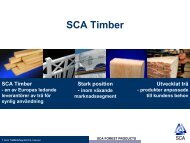timber news 3/2009 - SCA Forest Products AB
timber news 3/2009 - SCA Forest Products AB
timber news 3/2009 - SCA Forest Products AB
- No tags were found...
Create successful ePaper yourself
Turn your PDF publications into a flip-book with our unique Google optimized e-Paper software.
<strong>timber</strong><strong>news</strong>A magazine for <strong>SCA</strong>’s solid wood products customers | www.sca<strong>timber</strong>.com3<strong>2009</strong>Cutting costs and carbon dioxideInvestments boost competitivenessSolid wood customersfrom far afield visit Sweden
Boards from <strong>SCA</strong>on the shelvesat Home Depot1979, US chain Home Depot has opened more than2,200 DIY and home furnishing stores, with many oftheir shelves stacked with <strong>timber</strong> products from<strong>SCA</strong>’s sawmills in Rundvik and Bollsta.Planed <strong>timber</strong> products from <strong>SCA</strong> Timber are sold in almost 500 of US DIYchain Home Depot’s stores.Photo: Per-Anders SjöquistIn the space of 30 years, Home Depothas managed to establish itself as theworld’s biggest DIY and home furnishingchain. The company’s huge stores,many of which are open 24 hours a day,showcase everything you need to build ahouse, from floor to roof.Everything about Home Depot is on amassive scale. The Group’s 300,000employees are spread throughout the US,Canada, Mexico, Puerto Rico and China.More than 40,000 different products areavailable to the 22 million customers thatpass through the company’s doors everyweek.“Home Depot has broken the homedown to its smallest constituent components,”says Birgitta Boström, productmanager at <strong>SCA</strong> Rundvik. “The numberof barbecue grills available alone exceeds150.”A wide range of products at low prices,good parking facilities and excellent serviceare factors that have contributed togiving Home Depot 25th place onFortune’s list of the biggest companies inthe US. What’s more, it’s also one of themost lucrative, racking up profits in excessof USD 514 million for Q1 <strong>2009</strong>.The extensive range of building productson offer at Home Depot also includesplaned, environmentally labelled andbarcoded Swedish <strong>timber</strong> products thathave been adapted to be easily loadedonto customers’ roof racks. The selectgroup of suppliers who contribute toensuring that the shelves in Home Depotstores are never empty has included <strong>SCA</strong>Timber since 1997.Satisfying demanding customers suchas Home Depot demands a complexsupply and service puzzle where all piecesmust fit precisely together. Price and qualityare just two of the criteria that mustbe satisfied. Others include delivery reliability,service and product range.“We’ve successfully completed ourundertakings for over 10 years,” saysBoström.Once clear of the narrow eye of theneedle through which each supplier toHome Depot must pass, the potential forremaining in the exclusive group thatkeeps the shelves of the company’s morethan 2,000 stores filled is good.“Home Depot is one of <strong>SCA</strong> Timber’sbiggest customer,” summarises Boström.“Of the 180,000 cubic metres of productmanufactured at Rundvik, around 57,000cubic metres ships to Home Depot storesin the US. In addition, approximately14,000 cubic metres are shipped from<strong>SCA</strong>’s sawmill in Bollsta.”This means that <strong>SCA</strong> currently suppliesaround 25% of all solid wood productsexported from Sweden to the US, equatingto approximately 10% of all Europeansolid wood product exports to the samedestination.“Once the financial situation in the UShas stabilised and construction starts topick up, volumes will increase further,”believes Michael Wicklund of Kelowna,Canada, who is responsible for <strong>SCA</strong>Timber’s sales in the US and Canada.One of the key factors in the success ofRundvik sawmill maintaining good relationswith Home Depot over the past 10years is that the delivery chain has remainedintact, from forest all the way toshipping. In order for each load to beidentical, there must be a steady streamof raw material that is cut to the specifiedlength.“If you’ve miss something in onemonth, it’s impossible to recover duringthe next,” explains Boström.Every five weeks, a ship leaves the portat Rundvik and heads to Philadelphia,which is where <strong>SCA</strong> has its distributioncentre for the American market, with upto three weeks’ worth of product held instock on site.Using forecasts and stock level informationcollected from Home Depot’sstores, trucks and trains are ordered upto supply nine of Home Depot’s regionalwarehouses with solid wood productsfrom Rundvik and Bollsta. In turn, eachregional warehouse serves between 80and 120 Home Depot stores.“This means that planed 19x89 and19x140 boards from <strong>SCA</strong> Timber – infour different lengths – are sold in almost500 Home Depot stores,” says Boström,who has a positive view on the potentialfor taking over responsibility for supplyingmore of Home Depot’s regional warehouses.“The economic crisis has broughtmany sawmills to their knees,” she says.“And when they are unable to meet theircommitments, we will be in a position tomove in and fill the vacuum created.”Mats Wigardt3 | <strong>timber</strong><strong>news</strong>
Two for the price of one:Cutting costs and CO 2The link between cutting CO 2 emissions and cuttingbusiness costs was the focus of <strong>SCA</strong> Timber’sJune conference on ‘<strong>Forest</strong>s, Wood Supply and theLow Carbon Economy’.To mark the 10 th anniversaryof its FSC forest managementcertification, <strong>SCA</strong> TimberSupply’s special conference onCO 2 and cost reduction in Junebrought together business acrossthe wood supply chain, from procurementand sustainability managersto suppliers – builders’ and<strong>timber</strong> merchants and wood productmanufacturers.Conference delegate David Berryis managing director of independentbuilders’ merchants C&WBerry Ltd and <strong>timber</strong> chairman ofmerchant buying group CEMCO.“As individuals we have our ownpersonal concerns about climatechange. At business level we arealso aware of the government’sinterest in carbon reduction andare monitoring it closely,” he commented.”When tendering forbusiness, pre-qualification questionnairesnow demand that companiesare able to tick certainboxes such as <strong>timber</strong> certificationand waste management. As carbonbecomes a matter of competitiveadvantage, so companies will makethe changes necessary to continuewinning business.”The conference heard that thecarbon footprint of one cubicmetre of wood products from<strong>SCA</strong>, from tree nursery to despatchquayside in Sweden, is 33kg CO 2– roughly the footprint of onefamily-sized roast beef joint forSunday lunch, or to using 14 litresof diesel. Compared to other constructionmaterials, this equates toslightly more than five per cent ofthe emissions from the productionof a corresponding weight of aluminiumand far less than five percent of the emissions from thesame weight of PVC.The growth of one cubic metreof wood in <strong>SCA</strong>’s forests innorthern Sweden sequesters 1.3tonnes of carbon dioxide from theatmosphere. Since the growth in<strong>SCA</strong>’s forest is 25 per cent higherthan felling, a net total of 250 kgof carbon dioxide is sequesteredfor every cubic metre of sawn<strong>timber</strong> produced. Additional climatebenefits derive from <strong>SCA</strong> utilisingits production sawdust asbiofuel.<strong>SCA</strong> uses the sawdust from producinga cubic metre of sawn<strong>timber</strong> to make biofuel pellets forenergy. To put the additional benefitsinto perspective, if substitutingoil-based energy for this smallamount of pellets , the CO 2 emissionsfrom the oil would amountto more than the emissions from<strong>SCA</strong>’s production and transport ofthe cubic metre of sawn <strong>timber</strong>delivered to <strong>SCA</strong> Timber Supply inthe UK.CEMCO’s Timber group chairman David Berry of C & W Berry (right) talks with Rob Simpson of <strong>SCA</strong>.Many organisations in Britainthat fall beyond the scope of EUemissions trading are now subjectto a new cap and trade scheme:the Carbon Reduction Commitment.It affects <strong>SCA</strong>’s larger UKwood customers, many of whomwere amongst the conferenceaudience. From national builders’merchant chain Travis Perkins plc,Environmental Manager JezCutler was interested in the presentationof <strong>SCA</strong>’s carbon factsand figures: “Travis Perkins anticipatesthat customers will soon beasking for detailed information oncarbon footprint. We will in turnbe asking our suppliers for theirdata. It is good to see <strong>SCA</strong> bravelycontributing to the debate, andcoming forward with well-foundedinformation.”<strong>timber</strong><strong>news</strong> | 4
<strong>SCA</strong> Timber Supply’s Environmental& Quality AssuranceManager, Bob Bastow, had produceda model to help customerscalculate the effect of theirdemands upon <strong>SCA</strong> productcarbon footprints. His researchrevealed that delivering ‘small’orders increases the distributionelement of a product’s carbonfootprint by 50 per cent. Sinceroad transport is expected to beincluded in EU’s Emissions TradingScheme by 2013, this differencecan be translated intomoney.Bob Bastow, who has alreadyhelped many UK <strong>timber</strong> customersto achieve FSC-certification, isnow starting to help customers tomap their <strong>SCA</strong> product carbonfootprints: “Working togetherwith customers using our ‘carboncalculator’, an accurate figure canbe pinpointed for the CO 2 generatedfor each cubic metre of<strong>timber</strong> delivered to end users. Cuttingtransport and packaging willreduce everyone’s business costs,”Bob confirmed to conference delegates.<strong>SCA</strong> Timber Supply’s SalesDirector Stephen King detailed thecompany’s focus on helpingcustomers to reduce wood wasteby tailoring products to theirneeds. “We are now embarking ontechnical efficiency projects linkingthe whole supply chain, from <strong>SCA</strong>as producers through to the constructionand maintenance organisationswhich eventually utiliseour material in homes and buildings,”he outlined.“An interesting revelation, asyou start mapping carbon footprints,is that reducing carbondioxide emissions is very much amatter of efficient resource management”,said Robert Simpson,Managing Director of <strong>SCA</strong> TimberSupply. “In partnership with ourcustomers, we can enhance the climatebenefits of wood products.Efficient production, designing outwaste and developing efficient distributionreduces costs throughoutthe supply chain.”Mike Jeffree, Editor of Timber Trades Journal and Timber & Sustainable Building, kindly acted as host for theconference Q&A sessions. Here he puts <strong>SCA</strong>’s Bob Bastow under the spotlight.With several methodologies forcalculating carbon footprints currentlyavailable, delegate BobDeadman, Group Negotiator forGrafton Merchanting GB andSelco, gave his reaction to the <strong>SCA</strong>conference: “I found the proceedingsmost illuminating. The key isthat we should all move forwardtogether as an industry on carboncalculations and reporting. If wedon’t there’s a danger that carbonlabelling could become like foodlabelling in the UK, with so manysystems in operation that thepublic close their minds to thewhole issue. The road to perditon,as they say, is paved with goodintentions. The industry is beginningto move the right way butthere’s a distinct danger of fragmentation,which should be avoidedat all costs.”Meeting of minds: foreground – John White, CEO of the UK Timber Trade Federation (left) talks with JermainCheetham, Environmental Manager, Wolseley; rearground: Stephen King of <strong>SCA</strong> talks with Mark Bowers,Procurement Director, Timber Group, Saint-Gobain Building Distribution.Photo: Prestige Photography5 | <strong>timber</strong><strong>news</strong>
Strategic investmentsin good times and badOver the past 10 years or so, <strong>SCA</strong> has invested billionsof kronor in its sawmill business. This yearalone, investments worth almost SEK 600 millionare either underway or have been completed. Theinvestments are carefully planned and selected inorder to support and enable the implementation of<strong>SCA</strong> Timber’s strategy of becoming a strong supplierto the <strong>timber</strong> industry and builders’ merchantsector.Agood starting point for describing<strong>SCA</strong> Timber’s investmentsis 2000, whichsaw the opening of Bollsta andMunksund sawmills within thespace of just a few weeks. Bothinstances involved the purchase ofcompletely new pine sawmillplants of the highest calibre inEurope in terms of volume andtechnology. Furthermore, bothinvestments were worth SEK 500million each and constituted thebiggest investments in new sawmillsever made in northernSweden.“Since then, we’ve invested afurther SEK 1 billion in our sawmilloperations,” says Jerry Larsson,technical director at <strong>SCA</strong>Timber and responsible for thecompany’s investment programmesand plans. “A further SEK 500million has also been invested inprojects that are currently underwayor have been completed, andwe’re very clear about the directionwe intend to take over thenext few years.”Of course, one of the aims ofmaking such investments is toimprove efficiency and productivity.“Sawmills are becoming increasinglylike the processing industry,”says Larsson. “Facilitiesmust be large and efficient to becompetitive. When Bollsta andMunksund were built, they wereable to produce 2,000–2,500 cubicmetres annually per employee,In March, <strong>SCA</strong> Timber opened its window component factory in Munksundwhich at the time was the highestproduction rate in Europe. Today,our productivity is 50% higher,with the very best European millsaiming for a production of 5,000cubic metres annually peremployee. It’s always a fluidtarget.”Part of the company’s investmentstrategy has involved acquiringtechnology designed to improvethe assessment of the qualityand suitability of raw materials.“In all our sawmills, we nowemploy <strong>timber</strong> sorting that utilises3D measurement technology,” saysLarsson. “This technology allowsus to accurately select the correctlog for each product. We’re also inthe process of introducing x-raysorting in our larger pine sawmills.By using x-rays, we can determinethe proportion of heartwood in alog, which is particularly importantwhen making top-grade productssuch as window frames.“We’re also bringing automatedand reliable measurement technologyinto sawing, trimming andplaning. Manual assessment isbeing replaced with objective anduniform measurement. This meansthat we can set and satisfy precisequality criteria in a totally differentway.”<strong>SCA</strong> Timber has adopted twoprincipal directions in its strategy.Firstly, to become a supplier to thewood processing industry, providingproducts that have been madeready for the next stage in the processingchain and, secondly, tobecome a supplier of finished solidwood products to the builders’merchant sector.“We’ve improved our understandingof the needs of the <strong>timber</strong>industry and can, to an increasingextent and in conjunction with ourcustomers, find ways of eliminatingsteps in the processing chain,”says Larsson. “One example of thisis the window component factorywe commissioned in Munksundlast winter. Our customer has beenable to rationalise its raw materialsmanagement and so, by having anefficient facility, we can producefinished components that are compliantwith specific customerrequirements.“Our experience has been sogood that we’re investigating the<strong>timber</strong><strong>news</strong> | 6
us a strength and long-term visionthat the majority of our competitorslack.”After coffee, the party leaves ona coach for NorrPlant, <strong>SCA</strong>’snursery. There, they are greetedby Hans Forsmark and StefanSvedin, who explain the sensitiveprocess involved in transformingseeds into the 101 million saplingsproduced.The idea of using snow to protectsaplings from the cold duringthe winter is a little difficult tounderstand, particularly when thethermometer is showing that thetemperature outside the greenhousesis nearing 30 degrees abovezero.Saad Azmi, procurement managerfor the Casablanca-basedRobelbois Group, considers puttinga spruce sapling in the buttonhole of his jacket to take home,but believes that growing conditionsare probably much betterin Sweden than back home inMorocco.Hamid Hajoui, CEO of Marocaineet Nordique des Bois,Manorbois, another Casablancabasedcompany involved in <strong>timber</strong>imports, says that the entire eventis an excellent idea.“Getting to see sawmills andsharing experiences with colleaguesfrom other North Africancountries has been very valuable,”he summarises.Stefan Svedin of NorrPlant, <strong>SCA</strong>’s nursery facility, talks about the initial developmentof a spruce sapling.The journey then continues north,to <strong>SCA</strong>’s sawmill in Bollstabruk,where the delegates are welcomedby sawmill manager KatarinaLevin and guided in the directionof the sawmill buildings.“We’re a little tired,” admitsEssam Hussein of Alexandria Construction& Supply. “First therewas the long journey from Egypt,then the light nights, and finallythe packed programme of events.“But,” he adds quickly, “it’s allbeen very interesting and wellorganised.”Kristoffer Lundholm gives theparty a full tour of the sawmill,from <strong>timber</strong> intake to the unloadingdock. The visitors followin his wake with a growing senseof curiosity. Many question marksare straightened out and hundredsof photographs immortalise everydetail of the sawmill.Rayed Abdullah Al-Ajaji ofJeddah-based Al-Muhaidib BuildingMaterials is most impressed bywhat he saw at the NorrPlantnursery.“You’ve demonstrated longheldknowledge and expertise thatI wasn’t aware of before,” he says.Gilles Hotelin, CEO of theRobelbois Group, is also satisfiedwith the visit to Sweden. It isn’t thefirst time he had been to Sweden,but it is the first time he’s experiencedan event of such scope andimportance.“I’ve learned a lot of newthings,” he summarises. “But, aboveall, I’ve had the opportunity tomeet my colleagues and competitors.Despite everything, we’re allbrothers.”Mats WigardtSawmill manager Katarina Levin welcomes the delegates to Bollstabruk.About Uni4 Marketing <strong>AB</strong>:Uni4 Marketing <strong>AB</strong> is joint venture between <strong>SCA</strong>Timber, Holmen Timber, Martinsons Trä and SödraTimber.It is a leading supplier of solid wood products tothe Middle East and North Africa. In recent years,supplied volumes have increased substantially.9 | <strong>timber</strong><strong>news</strong>
In new postsLars-Erik Jönsson, Sawmill managerat Jämtlamell Sawmill.Lars-Erik, formerly site manager,has taken over as sawmill managerat Jämtlamell Sawmill.Faster loadingat <strong>SCA</strong>’s portsPhoto: Ingrid LöfqvistBy increasing the loading capacity at <strong>SCA</strong>’s ports by up to 75 percent, more goodscan be dispatched on fewer ships, thereby reducing costs.“We’ve become faster and more efficient,” summarises Lars Norberg, LogisticsManager at <strong>SCA</strong> Timber.For several years, Norberg has workedtirelessly to increase the capacity of<strong>SCA</strong>’s ports: Holmsund, Rundvik, Bollsta,Lugnvik, Sundsvall and Tunadal.The aim has been to ensure that, overtime, all ports will be in a position to handlea loading capacity of at least 300 cubicmetres per hour.“It was felt that we needed to conduct athorough review of procedures,” says Norberg.By regularly measuring port capacity, clearstatistics have been produced, making iteasier to get an overview of the long-termimprovement potential. The results of thesemeasurements have subsequently been discussedand analysed in a series of workingparties. Work times, internal communicationand management are just a few examplesof the issues addressed.“There’s no magic involved in our work,”says Norberg. “Quite the opposite, in fact.It’s simply a matter of openness and anexchange of experience, and accepting thepossibility of changing and developingoperations.”Through clarity and focus on the issue athand – making <strong>SCA</strong>’s ports more efficientand attractive to external agents and shippinglines – this ‘joined-up’ approach hassucceeded in improving loading capacityby between 50 percent and 75 percent,depending on the port.Less time in port equals lower costs andincreased competitiveness.“As in all periods of change, it’simportant that there’s also a change in attitude,”says Norberg and gives everyoneinvolved a big pat on the back for theirefforts.“Provided everyone realises that wemust save money and become more attractiveso that we don’t lose volume andthereby work opportunities, we will beable to achieve further major improvements,”he says.Mats WigardtStefan Wiklund, product managerat Jämtlamell Sawmill.Stefan, formerly assistant productmanager, has taken over as productmanager at Jämtlamell Sawmill.Anders Andersson, assistant productmanager at Tunadal Sawmill.Anders was most recently sitemanager at <strong>AB</strong> Norrby Såg. Hesucceeds Lena Larsson, who hasretired.<strong>timber</strong><strong>news</strong> | 10
Order <strong>SCA</strong> Timber’sProduct catalogueThe <strong>SCA</strong> Timber Product cataloguegives a comprehensive presentation of<strong>SCA</strong> Timber’s range of products, fromsawn standard products to processed solidwood products in both the Living-with-Wood and Building-with-Wood areas ofuse.The Product catalogue is available inEnglish and can be ordered through yourlocal <strong>SCA</strong> representative or direct viaingrid.lofqvist@sca.com. The catalogueis also available as a downloadable PDFfile from www.sca<strong>timber</strong>.com.Cutbacks in European production result ina dearth of sawn solid wood productsAfter a turbulent winter characterisedby the effects of the global financialcrisis, the market underwent radicalchange during Q2. Until the middleof March, the inflow of orders wasquite sluggish. Since then, however,demand for sawmill products hasgradually increased to a level wherewe no longer have the capacity to offera full range.During the past year, profitability inthe industry has been very weak,which has led to extensive productioncutbacks, particularly productionoriginating in the Eurozone.Between January and May, Europeanproduction was at 70 percent of the peakyear of 2007. This fall-off is so extensivethat prices are now rising rapidly, theresult of which is that production levelsare gradually starting to increase again.The financial crisis is having a significantnegative impact on residential andother types of new builds. This affectsboth construction companies and theirsubcontractors, e.g. the joinery industry.Customers’ profitability has been weakenedmarkedly, increasing the risk of sawmillslosing business.All major markets are reporting fallingfigures for the new build sector. Manyforecasts for this sector indicate thatvolumes will be two-thirds down onthose of recent years. Examples of suchforecasts include construction forecastspublished by the Swedish National Boardof Housing, Building and Planning andthe UK’s Construction <strong>Products</strong> Association.What’s important to remember, however,is that consumption of wood-relatedproducts in Europe is primarily linked tothe renovation, maintenance and conversionsector. Renovation is not monitoredto the same extent as new builds, whichis why these figures are not as readilyavailable. In our opinion, which is partlybased on <strong>SCA</strong> Timber’s business tobuilder’s merchants and outlets in the UKand Scandinavia, we in this importantsector will be experiencing a decline ofonly 5–10 percent.Production is now increasing again fromthe very low level during the winter andspring. The biggest problems are currentlybeing faced by the Finnish, Germanand Austrian industries, which are hamperedby a strong Euro and the need tokeep the cost of logs at reasonable levels.Russian production will continue toremain low due to a number of internalproblems primarily linked to the supplyof logs. However, Sweden will probablybe up to full production during theautumn. In my opinion, production levels(measured as an annual rate) for Europeas a whole will be down 10 percent duringthe autumn compared to 2008 (asagainst being down 30 percent during thespring). This reduction is on a par withreduced consumption and should constitutea sufficient limitation to balancesupply and demand.The price of sawn solid wood productsgrew rapidly during the latter part of thespring. Since March, the price of pine hasincreased by approximately 30 percentand spruce by approximately 20 percent.This improvement stems from lowerproduction. Following a further marginalincrease in prices during late summer, itis likely that the situation will remainrelatively stable for the rest of the year.The current increase in production willlimit these price spikes as consumptioncontinues to be weak as a result of thefinancial crisis.Anders Ek, Marketing Director, <strong>SCA</strong> Timber11 | <strong>timber</strong><strong>news</strong>
<strong>SCA</strong>’s only chapel celebrates100 years<strong>SCA</strong> doesn’t only own forests, sawmills,or paper and pulp facilities. Italso owns a chapel: Ljungå chapel insouth-east Jämtland. This year, thechapel will be celebrating its centenary.Over the years, the small, red-paintedchapel has been a focal point forpeople in the district, playing hostto numerous church services, christenings,weddings and funerals. Nowadays, servicesare primarily held in the chapel’slight and airy sanctuary on major holydays.There has been a chapel in Ljungåsince 1865. Skönviks <strong>AB</strong> built the firstchapel in the village, where the companyalready had forest holdings and owned asawmill.The original chapel was destroyed in afire and replaced with a new building in1909. The new chapel was designed inStockholm by the architect Karl RudolfTeodor Arborelius. The cost of the buildingcame to SEK 6,500, excluding of thecost of <strong>timber</strong>.In 1929, Skönviks <strong>AB</strong> became part of<strong>SCA</strong> and merged fully with the companyin 1954. Since then, Ljungå chapel hasbeen directly owned and managed by<strong>SCA</strong>.“Over the years, <strong>SCA</strong> has owned ninechurches and chapels,” says Kjell-ÅkeHermansson, head archivist at <strong>SCA</strong>. “Thereason for this lies far back in history,during the emergence of ironworks innorthern Sweden in the 17th and 18thcenturies and during the sawmill era ofthe 19th century. The aim was to satisfythe spiritual needs of the workers, withworks chapels and churches being builton the initiative of the works owners.”<strong>SCA</strong> has since gifted ownership of all itschapels and churches to the local parishes– with the exception of Ljungå chapel,which will be granted historic buildingstatus during the autumn.Photo: Per-Anders Sjöquist



